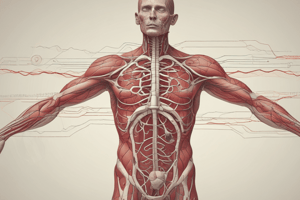Podcast
Questions and Answers
What is the primary function of the circulatory system?
What is the primary function of the circulatory system?
- To supply the body with nutrients
- To remove waste products
- To oxygenate the blood
- To transport materials throughout the body (correct)
What does the respiratory system supply to the blood?
What does the respiratory system supply to the blood?
Oxygen
What is the path of blood flow starting from the body?
What is the path of blood flow starting from the body?
Blood flows from the body to the superior and inferior vena cava, then to the right atrium, through the tricuspid valve to the right ventricle, through the pulmonic valve to the pulmonary artery, to the lungs, then returns through the pulmonary veins to the left atrium, and so on.
Capillaries connect arteries and veins.
Capillaries connect arteries and veins.
How do the circulatory and respiratory systems work together?
How do the circulatory and respiratory systems work together?
Gas exchange in the lungs occurs in the small air sacks called ______.
Gas exchange in the lungs occurs in the small air sacks called ______.
What occurs to the respiratory system when exercising?
What occurs to the respiratory system when exercising?
What is the process that occurs in the lungs to expel waste?
What is the process that occurs in the lungs to expel waste?
What happens to heart rate during exercise?
What happens to heart rate during exercise?
Match the following functions with the systems they belong to:
Match the following functions with the systems they belong to:
Flashcards are hidden until you start studying
Study Notes
Functions of the Circulatory System
- Acts as the body's transport system for blood.
- Delivers nutrients, food, and oxygen to body cells.
- Removes waste products such as carbon dioxide from cells.
- Pumps blood to the lungs for oxygen-carbon dioxide exchange.
Functions of the Respiratory System
- Supplies blood with oxygen for body delivery.
- Oxygen is inhaled and carbon dioxide is exhaled during the breathing process.
Path of Blood Flow
- Deoxygenated blood enters the right atrium via the superior and inferior vena cava.
- Blood moves through the tricuspid valve to the right ventricle.
- Blood is pumped through the pulmonic valve to the pulmonary artery and then to the lungs.
- Oxygenated blood returns via the pulmonary veins to the left atrium.
- Blood flows through the mitral valve to the left ventricle and is pumped through the aortic valve into the aorta, supplying the body.
Types of Blood Vessels
- Arteries carry blood away from the heart; the pulmonary artery carries oxygen-poor blood.
- Capillaries connect arteries and veins, facilitating nutrient and gas exchange.
Integration of Circulatory and Respiratory Systems
- Respiratory system gathers oxygen from the environment and delivers it to the lungs.
- The circulatory system transports oxygenated blood from the lungs to various body parts.
Gas Exchange in the Lungs
- Involves diffusion of oxygen through alveoli into the bloodstream.
- Carbon dioxide from the blood moves into the alveoli to be expelled upon exhalation.
- Fresh oxygen is inhaled and carbon dioxide is removed upon exhalation.
Physiological Changes During Exercise
- Increased demand for oxygen leads to enhanced respiratory function.
- Adrenal glands release adrenaline and noradrenaline, affecting heart function.
- Sympathetic nerves stimulate heart rate and stroke volume, improving cardiac output.
- Veins constrict to return more blood to the heart during increased physical activity.
Exercise Process
- Engagement in exercise leads to an increased heart rate and faster metabolism.
- Muscles demand more oxygen, prompting the heart to supply oxygen-rich blood quickly.
- Overall, blood flow speed increases to meet the needs of working muscles.
Studying That Suits You
Use AI to generate personalized quizzes and flashcards to suit your learning preferences.




